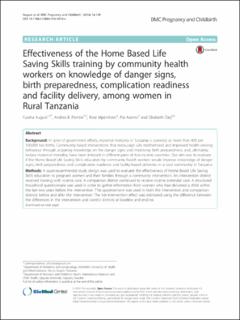| dc.contributor.author | August, Furaha | |
| dc.contributor.author | Pembe, Andrea | |
| dc.contributor.author | Mpembeni, Rose | |
| dc.contributor.author | Axemo, Pia | |
| dc.contributor.author | Darj, Elisabeth | |
| dc.date.accessioned | 2020-03-23T08:15:11Z | |
| dc.date.available | 2020-03-23T08:15:11Z | |
| dc.date.created | 2016-07-04T11:18:59Z | |
| dc.date.issued | 2016 | |
| dc.identifier.citation | BMC Pregnancy and Childbirth. 2016, 16 (129), . | en_US |
| dc.identifier.issn | 1471-2393 | |
| dc.identifier.uri | https://hdl.handle.net/11250/2648003 | |
| dc.description.abstract | Background
In spite of government efforts, maternal mortality in Tanzania is currently at more than 400 per 100,000 live births. Community-based interventions that encourage safe motherhood and improved health-seeking behaviour through acquiring knowledge on the danger signs and improving birth preparedness, and, ultimately, reduce maternal mortality, have been initiated in different parts of low-income countries. Our aim was to evaluate if the Home Based Life Saving Skills education by community health workers would improve knowledge of danger signs, birth preparedness and complication readiness and facility-based deliveries in a rural community in Tanzania.
Methods
A quasi-experimental study design was used to evaluate the effectiveness of Home Based Life Saving Skills education to pregnant women and their families through a community intervention. An intervention district received training with routine care. A comparison district continued to receive routine antenatal care. A structured household questionnaire was used in order to gather information from women who had delivered a child within the last two years before the intervention. This questionnaire was used in both the intervention and comparison districts before and after the intervention. The net intervention effect was estimated using the difference between the differences in the intervention and control districts at baseline and endline.
Results
A total of 1,584 and 1,486 women were interviewed at pre-intervention and post intervention, respectively. We observed significant improvement of knowledge of three or more danger signs during pregnancy (15.2 % vs. 48.1 %) with a net intervention effect of 29.0 % (95 % CI: 12.8–36.2; p < .0001) compared to the comparison district. There was significant effect on the knowledge of three or more danger signs during childbirth (15.3 % vs. 43.1 %) with a net intervention effect of 18.3 % (95 % CI: 11.4–25.2; p < .0001) and postpartum for those mentioning three or more of the signs (8.8 % vs. 19.8 %) with net effect of 9.4 % (95 % CI: 6.4–15.7; p < .0001). Birth preparedness practice improved for those who made more than three actions (20.8 vs. 35.3 %) with a net intervention effect of 10.3 % (95 % CI: 10.3–20.3; p < .0001) between the intervention and control district at pre-intervention and post intervention. Utilisation of antenatal care with four visits improved significantly (43.4 vs. 67.8 %) with net effect of 25.3 % (95 % CI: 16.9–33.2; p < .0001), use of facility delivery improved in the intervention area (75.6 vs. 90.2 %; p = 0.0002) but there was no significant net effect 11.5 % (95 % CI: -5.1–39.6; p = 0.123) compared to comparison district.
Conclusion
This study shows that a community-based intervention employing community health workers as teachers in delivering Home Based Life Saving Skills program to pregnant women and their families improved their knowledge of danger signs during pregnancy, childbirth and postpartum, preparedness for childbirth and increased deliveries at health facilities which employ skilled health workers in this rural community. | en_US |
| dc.language.iso | eng | en_US |
| dc.relation.uri | art%3A10.1186%2Fs12884-016-0916-x.pdf | |
| dc.rights | Navngivelse 4.0 Internasjonal | * |
| dc.rights.uri | http://creativecommons.org/licenses/by/4.0/deed.no | * |
| dc.title | Effectivness of Home Based Life Saving Skills training by community health workers on knowledge of danger signs, birth preparedness, complication readiness and facility delivery, among women in Rural Tanzania | en_US |
| dc.type | Peer reviewed | en_US |
| dc.type | Journal article | en_US |
| dc.description.version | publishedVersion | en_US |
| dc.source.pagenumber | 12 | en_US |
| dc.source.volume | 16 | en_US |
| dc.source.journal | BMC Pregnancy and Childbirth | en_US |
| dc.source.issue | 129 | en_US |
| dc.identifier.doi | 10.1186/s12884-016-0916-x | |
| dc.identifier.cristin | 1365922 | |
| dc.description.localcode | Open Access This article is distributed under the terms of the Creative Commons Attribution 4.0 International License (http://creativecommons.org/licenses/by/4.0/), which permits unrestricted use, distribution, and reproduction in any medium, provided you give appropriate credit to the original author(s) and the source, provide a link to the Creative Commons license, and indicate if changes were made. The Creative Commons Public Domain Dedication waiver (http://creativecommons.org/publicdomain/zero/1.0/) applies to the data made available in this article, unless otherwise stated. | en_US |
| cristin.ispublished | true | |
| cristin.fulltext | original | |
| cristin.qualitycode | 1 | |

